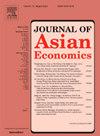Impact of heterogenous capabilities on export performance amid the digital transformation
IF 2.9
3区 经济学
Q1 ECONOMICS
引用次数: 0
Abstract
We investigate the effects of adopting digital technology on export performance of Korean manufacturing firms amidst the digital transformation. We recognize firm-level capabilities should be closely associated with adoption of rapidly progressing digital technology but also with export performance. And our data indicates that the most common purpose of digital technology adoption is to launch new products to the market. Hence, we consider that technology adoption is a strategic and purposeful decision to gain competitive edge mostly by producing new product, and treating technology adoption exogenous can be misleading. Due to the endogeneity and selection issues in technology adoption, the endogenous switching regression is applied to this study as Coad et al. (2020). On technology adoption decision, we find external innovative resources from strategic alliance in addition to internal innovative capabilities stand out. Given technology adoption decision, internal capabilities like patent rights and international affiliation are complementary factors to export growth. The treatment effect analysis has implications as follows: the result on contribution of technology adoption to export growth for actually adopting firms is rather small, and shows heterogenous innovation, organizational, and external capabilities are still critical factors as much as new products embedding high-end digital technology; the result on non-adopting firms indicates potential of advanced digital technology to improve export performance by helping to produce such new products if they were actually capable to do it. In sum, our findings provide another evidence that structurally positive interaction between innovative activities and export performance as Aw et al. (2011), since adoption of digital technology to products itself is innovative in the digital transformation. Furthermore, the result is consistent with the capability theory in that heterogenous innovative and complementary capabilities determine strategic technology adoption and export performance simultaneously. Finally, our findings indicate that the digital transformation might be still at the early stage. The fact that Korean firms have adopted advanced digital technology mainly for new products can be interpreted as an indicator of early development stage of transformation, since firms concentrate on product innovation than process innovation to gain competitive edge at the early stage (Utterback and Abernathy, 1975). Thus, we expect that further evolution of digital transformation can facilitate process innovation, then contribute to firm performance by improving cost efficiency that should be tackled in the upcoming study.
数字化转型中异质能力对出口绩效的影响
我们研究了韩国制造业企业在数字化转型中采用数字技术对出口绩效的影响。我们认为,企业层面的能力不仅与采用快速发展的数字技术密切相关,也与出口绩效密切相关。我们的数据表明,采用数字技术最常见的目的是向市场推出新产品。因此,我们认为采用技术是一种战略性的、有目的的决策,主要是通过生产新产品来获得竞争优势,而将采用技术视为外生因素可能会产生误导。由于技术采用中的内生性和选择问题,本研究采用了 Coad 等人(2020 年)的内生转换回归。在技术采用决策方面,我们发现除了内部创新能力外,来自战略联盟的外部创新资源也非常突出。在技术采用决策方面,专利权和国际关联等内部能力是出口增长的补充因素。处理效应分析具有以下意义:对于实际采用技术的企业,技术采用对出口增长的贡献结果相当小,这表明异质创新、组织和外部能力与嵌入高端数字技术的新产品一样,仍然是关键因素;对于未采用技术的企业,结果表明,如果它们确实有能力生产此类新产品,先进的数字技术有可能帮助它们提高出口绩效。总之,我们的研究结果提供了另一个证据,证明创新活动与出口绩效之间存在结构性的正向互动,正如 Aw 等人(2011 年)所言,因为产品采用数字技术本身就是数字化转型中的创新。此外,这一结果也符合能力理论,即异质创新能力和互补能力同时决定了战略技术的采用和出口绩效。最后,我们的研究结果表明,数字化转型可能仍处于早期阶段。韩国企业主要在新产品上采用先进的数字技术,这可以解释为转型处于早期发展阶段的一个指标,因为在早期阶段,企业集中于产品创新,而不是流程创新,以获得竞争优势(Utterback 和 Abernathy,1975 年)。因此,我们期待数字化转型的进一步发展能促进流程创新,进而通过提高成本效率来提升企业绩效,这也是下一步研究要解决的问题。
本文章由计算机程序翻译,如有差异,请以英文原文为准。
求助全文
约1分钟内获得全文
求助全文
来源期刊

Journal of Asian Economics
ECONOMICS-
CiteScore
4.70
自引率
9.40%
发文量
90
期刊介绍:
The Journal of Asian Economics provides a forum for publication of increasingly growing research in Asian economic studies and a unique forum for continental Asian economic studies with focus on (i) special studies in adaptive innovation paradigms in Asian economic regimes, (ii) studies relative to unique dimensions of Asian economic development paradigm, as they are investigated by researchers, (iii) comparative studies of development paradigms in other developing continents, Latin America and Africa, (iv) the emerging new pattern of comparative advantages between Asian countries and the United States and North America.
 求助内容:
求助内容: 应助结果提醒方式:
应助结果提醒方式:


